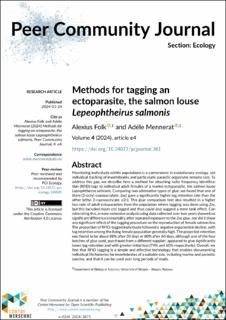| dc.contributor.author | Folk, Alexius Werner Thomas | |
| dc.contributor.author | Mennerat, Adele | |
| dc.date.accessioned | 2024-03-25T08:10:33Z | |
| dc.date.available | 2024-03-25T08:10:33Z | |
| dc.date.created | 2024-01-24T14:46:59Z | |
| dc.date.issued | 2024 | |
| dc.identifier.issn | 2804-3871 | |
| dc.identifier.uri | https://hdl.handle.net/11250/3123968 | |
| dc.description.abstract | Monitoring individuals within populations is a cornerstone in evolutionary ecology, yet individual tracking of invertebrates and particularly parasitic organisms remains rare. To address this gap, we describe here a method for attaching radio frequency identification (RFID) tags to individual adult females of a marine ectoparasite, the salmon louse Lepeophtheirus salmonis. Comparing two alternative types of glue, we found that one of them (2-octyl cyanoacrylate, 2oc) gave a significantly higher tag retention rate than the other (ethyl 2-cyanoacrylate, e2c). This glue comparison test also resulted in a higher loss rate of adult ectoparasites from the population where tagging was done using 2oc, but this included males not tagged and thus could also suggest a mere tank effect. Corroborating this, a more extensive analysis using data collected over two years showed no significant difference in mortality after repeated exposure to the 2oc glue, nor did it show any significant effect of the tagging procedure on the reproduction of female salmon lice. The proportion of RFID-tagged individuals followed a negative exponential decline, with tag retention among the living female population generally high. The projected retention was found to be about 88% after 30 days or 80% after 60 days, although one of the four batches of glue used, purchased from a different supplier, appeared to give significantly lower tag retention and with greater initial loss (74% and 60% respectively). Overall, we find that RFID tagging is a simple and effective technology that enables documenting individual life histories for invertebrates of a suitable size, including marine and parasitic species, and that it can be used over long periods of study. | en_US |
| dc.language.iso | eng | en_US |
| dc.rights | Navngivelse 4.0 Internasjonal | * |
| dc.rights.uri | http://creativecommons.org/licenses/by/4.0/deed.no | * |
| dc.title | Methods for tagging an ectoparasite, the salmon louse Lepeophtheirus salmonis | en_US |
| dc.type | Journal article | en_US |
| dc.type | Peer reviewed | en_US |
| dc.description.version | publishedVersion | en_US |
| dc.rights.holder | Copyright 2024 The Author(s) | en_US |
| dc.source.articlenumber | e4 | en_US |
| cristin.ispublished | true | |
| cristin.fulltext | original | |
| cristin.qualitycode | 1 | |
| dc.identifier.doi | 10.24072/pcjournal.361 | |
| dc.identifier.cristin | 2233870 | |
| dc.source.journal | Peer Community Journal | en_US |
| dc.relation.project | Norges forskningsråd: 287405 | en_US |
| dc.identifier.citation | Peer Community Journal. 2024, 4, e4. | en_US |
| dc.source.volume | 4 | en_US |

